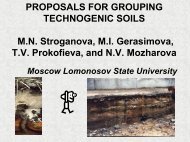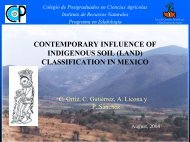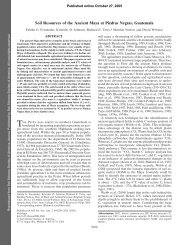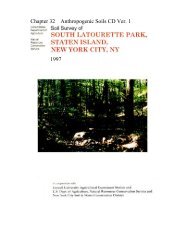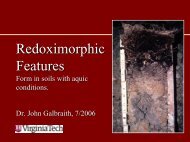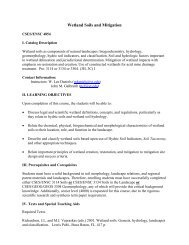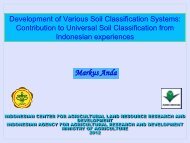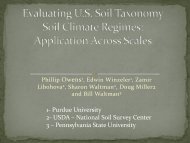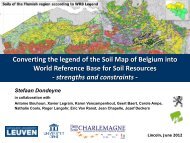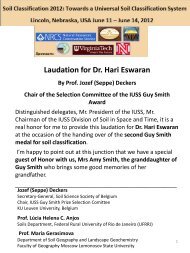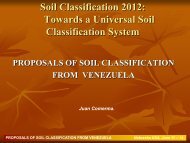Nebraska Soils Field Trip - Virginia Tech
Nebraska Soils Field Trip - Virginia Tech
Nebraska Soils Field Trip - Virginia Tech
You also want an ePaper? Increase the reach of your titles
YUMPU automatically turns print PDFs into web optimized ePapers that Google loves.
4th IUSS Soil Classification Conference <strong>Field</strong> Tour Guidebook<br />
Draft of new section on Artifacts for the National Soil Survey Handbook,<br />
Part 618--Soil Properties and Qualities<br />
618.5 Artifacts in the Soil<br />
A. Definition.—“Artifacts” are objects or materials created or modified by humans, usually for a<br />
practical purpose in habitation, manufacturing, excavation, or construction activities. Examples of<br />
artifacts include bitumen (asphalt), brick, concrete, metal, paper, plastic, rubber, and wood products.<br />
Artifacts are commonly referred to as “discrete artifacts” if they are 2 mm or larger in diameter and<br />
are not compacted into a root-limiting layer that impedes root growth or water movement.<br />
B. Significance.—Artifacts can constitute a significant portion of the soil. The amount and type of<br />
particulate artifacts can contribute substantially to various trace metals and total carbon contents of<br />
soils. Discrete artifacts which are both cohesive and persistent, defined below, are treated in a similar<br />
manner as rock fragments when populating the standard sieves or in calculations involving sieve<br />
entries. Discrete artifacts which are noncohesive, nonpersistent, or both are not considered fragments<br />
for sieve entries or calculations involving those entries.<br />
C. Measurement.—The fraction from 2 to 75 mm in diameter may be measured in the field.<br />
However, 50 to 60 kg of sample material may be necessary if there is an appreciable amount of<br />
fragments near 75 mm. An alternative means of measuring is to visually estimate the volume of the<br />
20 to 75 mm fraction, then sieve and weigh the 2 to 20 mm fraction. The fraction 75 mm (3 inches)<br />
or greater is usually not included in soil samples taken in the field for laboratory testing.<br />
Measurements can be made in the field by weighing the dry sample and the portion retained on a 3inch<br />
screen. The smallest dimension of discrete artifacts is used to determine whether these items<br />
pass through a sieve. The quantity is expressed as a weight percentage of the total soil. A sample as<br />
large as 200 pounds to more than a ton may be needed to assure that the results are representative.<br />
Measurements of the fraction from 75 to 250 mm (3 to 10 inches) and the fraction greater than 250<br />
mm (10 inches) in diameter are usually obtained from volume estimates.<br />
D. Estimates<br />
(1) Estimates of discrete artifacts are made similarly to the way estimates of rock fragments are<br />
made. These estimates are usually made by visual means and are on the basis of percent by<br />
volume. The percent by volume is converted to percent by weight by using the average bulk<br />
unit weights for the soil and the specific artifacts. These estimates are made during<br />
investigation and mapping activities in the field. They are expressed as ranges that include<br />
the estimating accuracy as well as the range of values for a component.<br />
(2) Treated and untreated wood products (e.g., lumber) are considered artifacts. They are not<br />
considered wood fragments such as those associated with the woody materials (e.g., tree<br />
branches) described in organic soils.<br />
(3) Measurements or estimates of discrete artifacts less than strongly cemented are made prior to<br />
any rolling or crushing of the sample.<br />
E. Artifact Cohesion<br />
(1) Definition.—“Artifact Cohesion” is the relative ability of the artifact to remain intact after<br />
significant disturbance.<br />
(2) Significance.—Artifacts that break down easily are similar to pararock fragments in that<br />
these artifacts break down to become part of the fine-earth fraction of the soil. Noncohesive<br />
artifacts are excluded from entries for the standards sieves and are not used in sieve<br />
calculations.<br />
138



